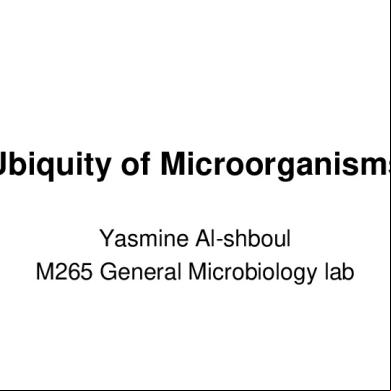Ubiquity Of Microorganisms 1u3t6h
This document was ed by and they confirmed that they have the permission to share it. If you are author or own the copyright of this book, please report to us by using this report form. Report 3b7i
Overview 3e4r5l
& View Ubiquity Of Microorganisms as PDF for free.
More details w3441
- Words: 426
- Pages: 17
Ubiquity of Microorganisms Yasmine Al-shboul M265 General Microbiology lab
Microorganisms are ubiquitous • Bacterial species characteristics: • • • • •
Colony morphology. Cell morphology. Biochemical properties. Antibiotic sensitivity. ** Knowledge of these characteristics allows correct & easy identification of bacteria from mixed cultures
• Principle of colony formation: • 1 cell 1 colony
•
Growth characteristics of bacterial colonies (on Agar):
• •
Size (mm-cm) Pin point, small, medium, large
• •
Elevation (side view): Flat, raised, convex, umbonate, crateriform.
• •
Edge or margin: Entire, lobate, curled, undulate, filamentous (filiform), erose.
• Whole colony shape (Form): • Filamentous, irregular, circular, rhizoid. • Texture: • Moist, mucoid, dry (rough) • • • •
Pigmentation: Color of colony may change on different agar types. Appearance: (Opaque or translucent), (shiny or dull).
• Odor (listed if distinctive) • Sweet, putrefied, fruity.
Colony morphology
pseudomonas aeruginosa
• Slant and deep media
Motility test.
Growth characteristics in broth:
• Aseptic Technique: • A procedure used in microbiology laboratories that protects the person, others, the work area, and the culture from contamination.
Suggested procedures to use to achieve Aseptic Technique: • Covering & sterilizing of culture media during preparation. • Sterilization of bench tops before and after use. • Sterilization of inoculation loop. • Do not talk while cultures are open. • Never leave a tube or a plate open any longer than necessary. • Flame the lips of the tube before and after inoculation with the loop. • Work quickly on all transfers. • Never place the cap or plug on the work surface or let it touch anything except the flamed lip and culture tube. • Wash hands before and after work.
Techniques for isolation of pure cultures • 1- Streak plate method: • - The most widely used method for obtaining isolated colonies from a mixed culture. • - It's a qualitative method that depends on dilution. • - 1 cell 1 colony. • - Procedure.
• streaking method
• • •
2- Spread-plate Technique. - Not commonly used - Procedure.
–
•
• • • • •
Sub-culturing: Transfer of microorganisms from one media to another by one of the transfer instruments. Transfer instruments Inoculating loops and needles: Made of Ni-chrome or Platinum. Flaming = incineration. Flaming begins at handle tip, this will prevent formation of aerosols.
• • •
Pipettes: Sterile & prepackaged. Disposable (in a biohazard box).
• • •
Swabs: Sterile & prepackaged. Disposable (in a biohazard box).
• • •
3- Pour-plate Technique: - Not commonly used - Procedure.
Microorganisms are ubiquitous • Bacterial species characteristics: • • • • •
Colony morphology. Cell morphology. Biochemical properties. Antibiotic sensitivity. ** Knowledge of these characteristics allows correct & easy identification of bacteria from mixed cultures
• Principle of colony formation: • 1 cell 1 colony
•
Growth characteristics of bacterial colonies (on Agar):
• •
Size (mm-cm) Pin point, small, medium, large
• •
Elevation (side view): Flat, raised, convex, umbonate, crateriform.
• •
Edge or margin: Entire, lobate, curled, undulate, filamentous (filiform), erose.
• Whole colony shape (Form): • Filamentous, irregular, circular, rhizoid. • Texture: • Moist, mucoid, dry (rough) • • • •
Pigmentation: Color of colony may change on different agar types. Appearance: (Opaque or translucent), (shiny or dull).
• Odor (listed if distinctive) • Sweet, putrefied, fruity.
Colony morphology
pseudomonas aeruginosa
• Slant and deep media
Motility test.
Growth characteristics in broth:
• Aseptic Technique: • A procedure used in microbiology laboratories that protects the person, others, the work area, and the culture from contamination.
Suggested procedures to use to achieve Aseptic Technique: • Covering & sterilizing of culture media during preparation. • Sterilization of bench tops before and after use. • Sterilization of inoculation loop. • Do not talk while cultures are open. • Never leave a tube or a plate open any longer than necessary. • Flame the lips of the tube before and after inoculation with the loop. • Work quickly on all transfers. • Never place the cap or plug on the work surface or let it touch anything except the flamed lip and culture tube. • Wash hands before and after work.
Techniques for isolation of pure cultures • 1- Streak plate method: • - The most widely used method for obtaining isolated colonies from a mixed culture. • - It's a qualitative method that depends on dilution. • - 1 cell 1 colony. • - Procedure.
• streaking method
• • •
2- Spread-plate Technique. - Not commonly used - Procedure.
–
•
• • • • •
Sub-culturing: Transfer of microorganisms from one media to another by one of the transfer instruments. Transfer instruments Inoculating loops and needles: Made of Ni-chrome or Platinum. Flaming = incineration. Flaming begins at handle tip, this will prevent formation of aerosols.
• • •
Pipettes: Sterile & prepackaged. Disposable (in a biohazard box).
• • •
Swabs: Sterile & prepackaged. Disposable (in a biohazard box).
• • •
3- Pour-plate Technique: - Not commonly used - Procedure.










